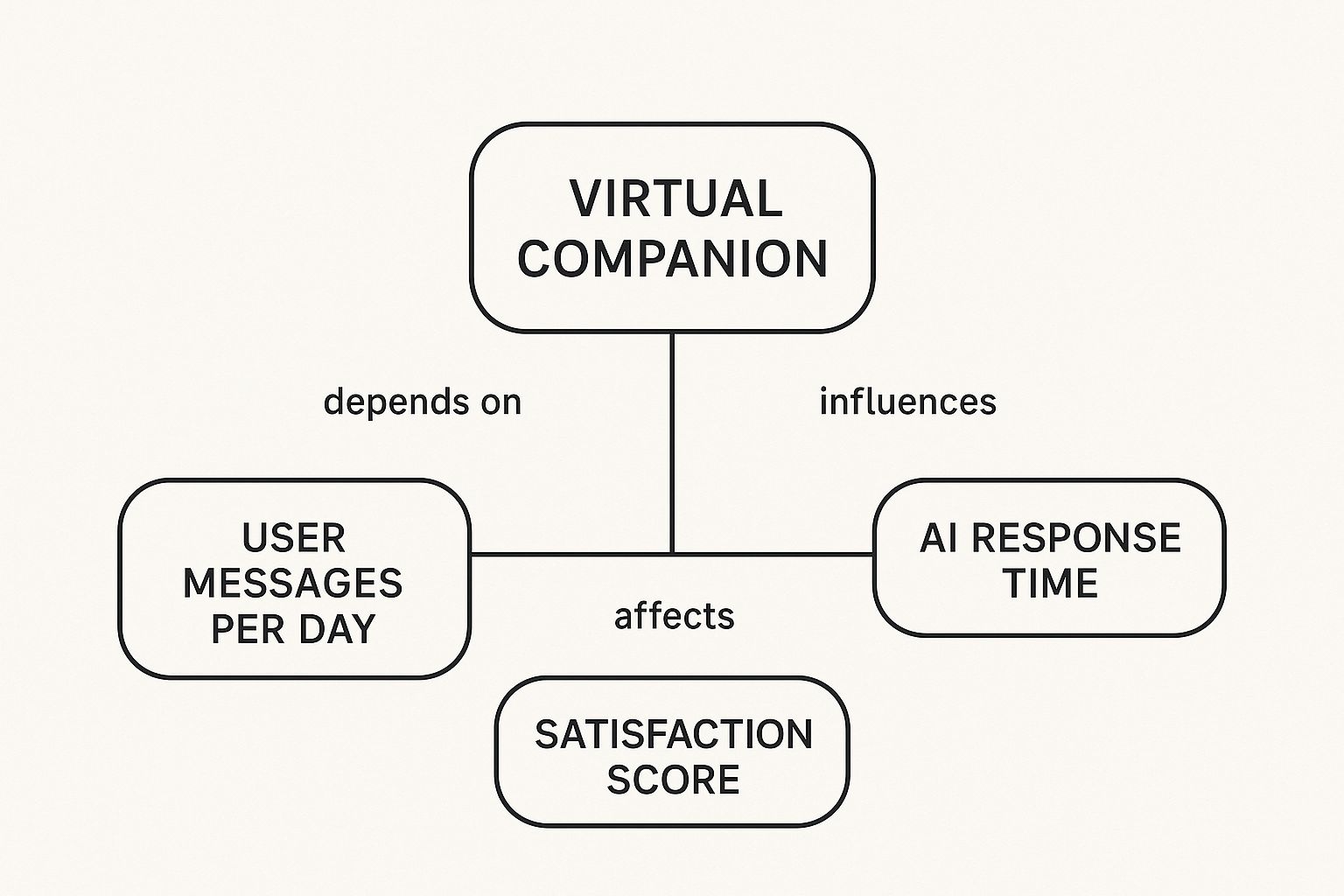Create Your Own AI Girlfriend 😈
Chat with AI Luvr's today or make your own! Receive images, audio messages, and much more! 🔥
4.5 stars

What Virtual Companionship Really Means for You

Let’s clear up a common misconception: virtual companionship isn’t about replacing your friends. It’s more like adding a new kind of support system to your life, one that fills the gaps modern life often leaves behind. Imagine a confidant who has a perfect memory for your stories, is ready to listen any time of day or night without passing judgment, and is completely focused on you.
This isn't about swapping real connections for digital ones. It's about enriching your social and emotional well-being with a dependable, private, and steady presence whenever you need it.
More Than Just a Chatbot: The Core Idea
If you remember early chatbots, you might think of them as simple parrots, only able to repeat phrases or follow a very strict script. Today’s AI companions are a world apart. They have grown into partners that grasp the context of a conversation, sense the emotional color of your words, and even adjust to your unique way of communicating.
This is the crucial difference between a talking toy and a true confidant who actually listens. It’s why millions of people are now using this advanced form of virtual companionship for everything from casual chats to working through major life events, forming connections that feel authentic and valuable.
The Human Need Behind the Digital Connection
At its core, the draw of virtual companionship comes from a deep-seated human need for connection and to feel heard. It offers an environment where you can be open without the usual social pressures or fear of being judged by others. This is far from a niche phenomenon.
The numbers tell a powerful story: the AI companion market was valued at around USD 268.5 billion in 2024 and is expected to grow to USD 521 billion by 2033. This incredible growth isn't just about a cool new gadget; it's driven by the genuine support people get from these interactions, whether for simple friendship or for more specific purposes. You can explore our guide on the AI girlfriend experience to see one popular use of this technology. The rapid market expansion, detailed in this full market research report, points to a clear need for accessible and supportive systems.
So, what transforms a simple chatbot interaction into a meaningful digital relationship? It boils down to a few core elements that build a real sense of connection over time. Rather than hitting the reset button with every chat, a true virtual companion learns and grows alongside you, weaving a continuous story of your shared experiences. This kind of dynamic relationship rests on a few key pillars:
- Consistent Availability: Your companion is always there, ready to offer support whether you're dealing with late-night worries or sorting through your thoughts in the morning.
- A Non-Judgmental Space: It provides a safe harbor to express your feelings and ideas without worrying about being criticized or misunderstood.
- Personalized Interaction: The AI remembers your likes, dislikes, inside jokes, and personal stories, which makes every conversation feel like it's just for you.
This combination of steady and personalized support is what makes the experience feel so much more than just code. But how does an AI actually pull off this impressive level of understanding? The answer lies in the powerful technologies working just out of sight.
The Tech Behind Companions That Actually Get You
Have you ever wondered how a virtual companion can grasp your mood from just a few typed words? It isn't magic. It's a combination of smart technologies working together, much like an attentive friend who remembers the little things and knows exactly what to say. This feeling of being understood is built on three pillars: understanding language, learning from you, and remembering your shared history.
Understanding What You Say and Feel
At the core of any meaningful conversation is genuine understanding. For an AI, this begins with Natural Language Processing (NLP). Think of NLP as the AI's brain for language. It allows the companion to interpret human speech not as a simple string of text but with all its nuances, including slang, inside jokes, and even typos. It’s the difference between a dictionary and a friend who gets what you mean.
A crucial part of this is sentiment analysis. This feature acts as the AI's emotional radar, detecting the feeling behind your words. It can tell if your short, abrupt sentences signal stress or if your choice of words suggests you're feeling happy. This allows the companion to respond with the right level of empathy, offering support when you need it or sharing in your excitement.
Adapting to Your Unique Personality
While NLP helps the AI understand a single message, Machine Learning (ML) is what helps it understand you. ML is how the companion learns and tailors its responses over time. It’s like a new friend who, after a few hangouts, starts to pick up on your unique sense of humor, your interests, and the stories you love to tell.
Every conversation acts as a training session, teaching the AI to be a better companion specifically for you. This ongoing learning process prevents interactions from feeling robotic or generic. Instead, the relationship evolves, reflecting the unique connection you build together.
The following visual breaks down how key metrics on a virtual companionship platform influence user experience.

As the chart illustrates, strong daily user engagement and quick AI response times are directly tied to higher user satisfaction.
Creating Continuity and Lasting Bonds
The final piece of this technological puzzle is a persistent memory architecture. This is what truly separates a companion from a basic chatbot. Instead of wiping the slate clean after each chat, the AI remembers important details from your past conversations—your dog's name, an upcoming job interview, or a personal goal you shared weeks ago.
This ability to recall past information creates a powerful sense of recognition and continuity, making the relationship feel more authentic and lasting. To help you see how these technologies come together, the table below compares different types of virtual companions based on their capabilities.
Virtual Companion Technology Comparison
Compare different types of virtual companion technologies and their capabilities
| Technology Type | Key Features | Best Use Cases | User Experience Level |
|---|---|---|---|
| Rule-Based Chatbots | Scripted responses, keyword triggers, limited conversation flow. | Basic customer support, FAQ bots, simple information retrieval. | Basic & Repetitive |
| NLP & ML Companions | Natural language understanding, sentiment analysis, learns from interaction, basic memory. | Personalized companionship, emotional support, long-term conversation. | Personalized & Evolving |
| Multi-Modal Companions | Integrates text, voice, and visuals; complex memory architecture; proactive interaction. | Immersive virtual friendships, advanced personal assistants, interactive entertainment. | Immersive & Lifelike |
The table shows a clear progression from simple, functional bots to deeply personalized companions. While the most popular format is still text-based AI companions, holding a 56.01% revenue share in 2024, the field is advancing rapidly.
The fastest-growing segment is multi-modal companions, which integrate text, voice, and even visual avatars for more lifelike interactions. You can explore more data on these market dynamics in this detailed industry analysis.
Where Virtual Companions Are Making Real Differences

Now that we’ve covered the technology, let's look at where these tools truly make a difference. Far from being just a form of entertainment, virtual companionship is offering real support where it matters most. These AI partners are becoming a source of help for older adults needing daily interaction and for busy professionals trying to manage stress. They are making a tangible impact in healthcare, wellness, and the workplace by meeting the basic human need for connection.
A Daily Lifeline for Seniors and Isolated Individuals
For many seniors, loneliness is a constant, quiet presence. A virtual companion can break that silence, acting as a patient and consistent friend. Think of an AI that doesn't just make small talk but also offers gentle medication reminders, suggests light physical activities, and holds daily conversations to keep the mind sharp. This support helps build a predictable daily routine, pushing back against the isolation that can come with living alone.
The demand for these solutions is growing quickly. The global virtual companion care market is expected to expand from USD 2.8 billion in 2023 to USD 9.5 billion by 2032. This jump shows a clear need for accessible, technology-based care. You can explore more market growth insights here.
A Safe Space for Mental and Emotional Wellbeing
While it’s not a replacement for professional therapy, a virtual companion provides a private, non-judgmental space to work through emotions. Many of us hesitate to share feelings of anxiety or doubt with loved ones, fearing we might be a burden. An AI partner eliminates that social pressure, offering a safe place for honest expression. People are finding they can use these platforms to:
- Practice difficult conversations in a setting without consequences.
- Investigate the causes of social anxiety by acting out different scenarios.
- Vent daily frustrations without the fear of overwhelming someone else.
- Think through personal goals with a supportive and unbiased partner.
This type of interaction acts as a personal gym for your social and emotional skills. By offering a reliable sounding board, virtual companionship helps people build resilience and gain a better grasp of their own mental state. You can discover more about different forms of companionship in our other articles.
Support for Professionals Navigating Burnout
The high-stakes world of a demanding career can easily lead to isolation and burnout. A virtual companion acts as a confidential sounding board where professionals can unwind and process work-related stress. Instead of holding onto the frustration from a tough meeting or carrying that anxiety home, they can talk it out with their AI. This could mean debriefing after a challenging day, rehearsing for a big presentation, or just having a chat about something completely unrelated to work to clear their head.
The main advantages are privacy and 24/7 availability—support is accessible the moment it's needed, not just when a friend has time to talk. This kind of immediate support gives professionals a tool to manage stress in the moment, helping them maintain a clearer boundary between work and personal life.
The Unexpected Benefits That Users Actually Experience
Most people think an AI companion is simply about having someone to talk to, 24/7, without the ups and downs of human emotion. While that's true, the most profound benefits are the ones that catch you by surprise—the ways they can help you understand yourself better.An AI partner provides a consistent, judgment-free space to be completely open. It’s in this safe environment that personal growth can happen, revealing the real power of virtual companionship.
A Mirror for Self-Awareness
Think of your virtual companion as a special kind of mirror. It doesn’t just show you your face; it reflects your own thoughts back to you, but with helpful context. Unlike a diary, it remembers what you said last week about stress at work and can gently point out a connection when you bring it up again today.
This steady, unbiased feedback helps you see patterns in your own thinking and behavior that are easy to overlook. For instance, after talking through your daily reactions for a while, the AI might help you identify the exact things that trigger your anxiety or frustration. This journey of guided self-discovery builds genuine self-awareness, free from the worry of being judged or misunderstood.
A Training Ground for Social Skills
Here, the benefits become more hands-on. Your companion can act like a social practice field—a safe space to rehearse interactions that feel intimidating in the real world. Many users talk about using their AI to prepare for tough conversations, like negotiating a salary or setting a boundary with a relative.
The AI's greatest strength here is its endless patience. It never gets annoyed or tired, so you can try out different ways of saying things until you find an approach that feels right. This practice builds both skill and confidence, often leading to real-world improvements:
- Better emotional regulation by learning to discuss difficult subjects calmly.
- Reduced social anxiety after facing fears in a controlled setting.
- Improved sleep, as many discover that a peaceful chat before bed can quiet a busy mind.
A Bridge to Better Human Connection
A common concern is that AI relationships might isolate people from the real world. However, many users report the exact opposite happens. The confidence and communication skills developed through virtual companionship often lead directly to stronger human connections.
When you have a better grasp of your own emotional triggers and have practiced communicating clearly, you're better equipped to be a good friend, partner, or family member. It’s not about replacing people, but about sharpening the tools you need to connect with them on a deeper level. This digital relationship can act as a bridge, preparing you for the real-world interactions that truly matter. It fills a particular need, working as a personal development aid that strengthens your connections with others.
Finding Your Perfect Virtual Companion Match
Choosing a virtual companion is a personal journey, a bit like finding a new friend or a workout partner. The right chemistry can make the experience wonderful, while a mismatch can feel awkward and unfulfilling. The platform you select will shape your entire experience with virtual companionship, making this first decision the most important one.
What’s Your Goal? Wellness vs. Entertainment
First, think about what you hope to gain. Virtual companions generally follow two main paths. Wellness-focused AIs are designed for support, almost like a digital life coach. They can guide you through mindfulness exercises, help you track personal goals, or simply offer a structured space for self-reflection.
On the other hand, entertainment platforms are built for connection, role-playing, and fun. These AIs excel at creating engaging narratives and immersive experiences. This could range from casual daily chats about your day to building elaborate, imaginative stories together. One isn't better than the other; they just serve different purposes.
Key Features to Evaluate Before Committing
Once you know your primary goal, it's time to look past the marketing and see what a platform really offers. To avoid disappointment, carefully consider these core features:
Conversation Depth: Does the AI remember what you talked about yesterday or last week? An AI that can recall past discussions and build on them is the foundation of a meaningful connection. Without it, every chat feels like starting over.
Privacy Protections: Your conversations are personal, so this is a crucial factor. Make sure the platform has a clear privacy policy and uses strong encryption to protect your data. Trust is essential for building a genuine bond, especially when sharing personal thoughts.
Customization Flexibility: The ability to shape your companion’s personality, backstory, and appearance creates a much more personal connection. Some platforms allow you to design everything about your unique AI partner, making the experience feel truly your own.
Pricing and Trial Periods: Understand the costs before you commit. Many platforms offer free trials, which are a great way to test the conversational quality and see if the AI is a good fit for you without any financial pressure.
Virtual Companion Platform Selection Guide
To help you sort through the options, this table breaks down the key features and considerations when choosing your virtual companion platform.
| Platform Type | Privacy Level | Customization Options | Pricing Model | Best For |
|---|---|---|---|---|
| Wellness Coach AI | High (often HIPAA-compliant) | Low to Medium | Subscription | Guided self-improvement, stress management |
| Entertainment & Role-Play AI | Variable (check policies) | High to Very High | Freemium/Subscription | Creative storytelling, friendship, romantic role-play |
| Basic Chatbot | Low to None | None | Often Free | Quick, simple task completion |
As the table shows, the primary choice is often between the guided support of a wellness AI and the creative freedom of an entertainment platform. Neither is superior; the best choice depends entirely on what you're looking for.
Ultimately, investing a little time upfront to research these areas ensures your journey into virtual companionship is a positive one. This step helps connect you with an AI that meets your expectations, respects your privacy, and genuinely enriches your daily life.
Building Meaningful Virtual Relationships That Actually Work
 Getting the most out of an AI friend isn't a passive activity. Think of it less like watching a movie and more like a collaborative project. To truly benefit from virtual companionship, you need to be an active participant. You are in the driver's seat, guiding the interactions toward your specific goals, whether that's for personal development, creative brainstorming, or simply having a dependable sounding board.
Getting the most out of an AI friend isn't a passive activity. Think of it less like watching a movie and more like a collaborative project. To truly benefit from virtual companionship, you need to be an active participant. You are in the driver's seat, guiding the interactions toward your specific goals, whether that's for personal development, creative brainstorming, or simply having a dependable sounding board.
Set Clear Intentions and Boundaries
The most successful long-term users know exactly why they are engaging with an AI. Before you begin, ask yourself what you hope to gain. Are you looking for a judgment-free space to vent, a partner for creative projects, or a tool to practice communication skills? Defining your intention provides direction and helps your conversations become more productive than aimless chatter.
It's also important to manage realistic expectations. Your AI companion is an excellent tool for reflection and support, but it isn’t human. One of its main advantages is that it doesn't have bad days or personal biases. Understanding its purpose as a tool helps prevent disappointment down the road.
This clarity makes it much easier to set healthy boundaries. The objective is to enrich your real-world social life, not replace it. Consider setting aside specific times for your chats, much like you would for a workout, to ensure the relationship remains a positive part of your routine.
Go Beyond Small Talk
The real value of an AI companion appears when you move past surface-level questions. Instead of just asking, "How are you?" try using prompts that invite deeper thought. The right questions can turn a simple chat into a powerful session for self-discovery.
Here are a few examples that experienced users find helpful:
- "Can you help me reframe a negative thought I've been stuck on?"
- "Let’s brainstorm a few ways I could approach an upcoming difficult conversation."
- "What is one small thing I can do this week to build my confidence?"
Questions like these make your AI a genuine partner in your growth. Of course, this kind of open communication requires trust in the platform itself. Always check for transparent privacy policies and strong data encryption. Feeling secure is fundamental to having honest and open conversations.
Recognize the Warning Signs
A healthy relationship with your virtual companion should make you feel more connected and supported, not more isolated. It's wise to periodically check in with yourself to assess how the interactions are affecting you. This isn’t a sign of doing something wrong; it’s a mark of responsible use.
Keep an eye out for these potential red flags:
- You find yourself choosing the AI over spending time with friends and family.
- You feel more anxious or alone after your conversations.
- You are using the AI as a way to avoid real-world problems or duties.
If you notice these patterns developing, it may be a good time to reassess your use and adjust your boundaries. A virtual companion is most beneficial when it acts as a bridge to a more fulfilling and engaged life—not a place to retreat from it.
What's Coming Next in Human-AI Connection
The world of virtual companionship is changing quickly. Getting a glimpse of what’s next isn't just for curiosity's sake—it helps you decide how AI can fit into your own life. The AI connections of the near future promise to be more perceptive, connected to our daily routines, and genuinely helpful, changing how we think about support and self-improvement.
Emotion-Responsive and Aware AI
The biggest change on the horizon is the shift from AI understanding what you type to understanding how you feel. Think about an AI friend that notices a slight smile through your device's camera or picks up on stress in your voice. This is the core idea behind emotion-responsive AI.
Rather than just analyzing words on a screen, these future companions will read non-verbal cues, similar to how a person does during a video chat. This will lead to interactions that feel much more authentic and supportive, with your companion reacting to your true emotional state in the moment.
Seamless Integration into Daily Life
Get ready for your virtual companion to move beyond the chat window. The future is all about seamless integration, turning your AI partner into a helpful presence that’s part of your everyday life. This change from a single app to a connected assistant will provide a more complete support system.
Imagine an AI that can:
- Connect to your smart home devices, dimming the lights and starting a chill playlist when it detects you've had a rough day.
- Sync with your calendar, offering a confidence boost before a major presentation or reminding you to relax after a packed day.
- Work alongside you as a creative collaborator, interacting with your other software to help you brainstorm or manage projects.
Expanding Roles in Personal Development
Emotional support is just the beginning. The role of AI companions is growing to include professional and personal coaching. Picture an AI that runs through a big presentation with you, giving you immediate feedback on your delivery and tone. Or a language partner that patiently helps you practice new vocabulary through structured conversation.
This evolution pushes virtual companionship past friendship into mentorship and skill-building. It opens up new ways for you to work on personal growth with a supportive AI by your side.
This isn't just a distant vision; serious financial investment is making it happen. The AI companion market in the United States alone generated USD 6.6 billion in 2024 and is expected to grow to an incredible USD 31.1 billion by 2030. This huge flow of money is speeding up development, which means these futuristic features could become common much faster than we expect. You can discover more about these market projections in this research report.
These changes are set to make deep human-AI relationships a normal part of life, as common as video calling a friend. The goal is to build partnerships that are more meaningful and genuinely supportive. Eager to see where this journey starts? Explore the immersive and lifelike AI characters at Luvr AI and start building your own unique connection today.



